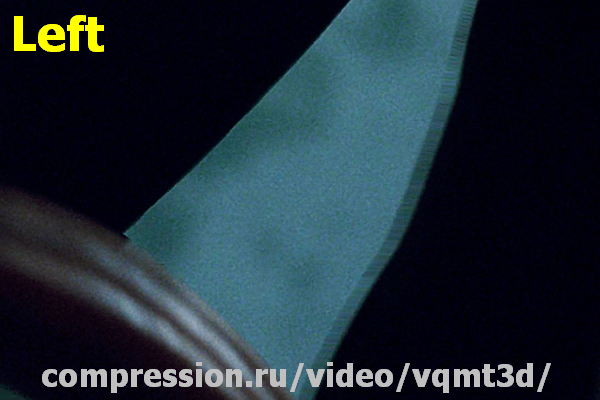MSU Graphics & Media Lab Report #5 on stereo films quality assessment
April 11.—The stereo 3D (S3D) film industry is now experiencing a drop in interest. Some people even think that the industry is dying and has no future. And a key factor in its decline is the poor quality of the 3D content which causes eyestrain and sometimes even severe headaches and nausea. The Graphics & Media Lab CMC of Lomonosov Moscow State University (further: the Lab) in cooperation with IITP RAS decided to investigate this problem.
The Lab already has over 10 years of experience in comprehensive analysis of quality of compressed video. In the area of 3D video quality it has already released 4 reports since March 2013 presenting the evaluation of 20 S3D films altogether.
The 1, 2, 4 reports were focused on films captured with stereoscopic camera systems, and the main problems discovered during the film analysis were:
- excessive horizontal disparity
- vertical disparity (Image #1)
- color mismatch
- sharpness mismatch

Image #1: Example of the vertical disparity
Third report was dedicated to quality analysis of 2D-3D conversion which introduces a lot of new problems that are absent in captured S3D video. The analysis included the following common converted S3D video issues:
- the cardboard effect
- edge-sharpness mismatch (Image #2)

Image #2: Example of the edge-sharpness mismatch
The Lab received a lot of positive comments from professional stereographers on these reports and was encouraged to continue the work on stereo film evaluation. The next two reports will be dedicated to the analysis of a stereo-window violation effect, which may be especially annoying in the more visible parts of the image. This issue appears in both captured and converted S3D films.
And now we would like to introduce the fifth report, in which the analysis of converted S3D films quality was continued. The report includes the following films:
- The Avengers
- The Chronicles of Narnia: The Voyage of the Dawn Treader
- Gulliver’s Travels
- Immortals
- Wrath of the Titans
The main new feature introduced in this report is the analysis for inconsistencies between stereo disparity and motion, which enables the automated detection of shots where inaccurate depth map was used for 2D-3D conversion (Image #3).

Image #3: Example of the inaccurate depth map use
The overall comparison of films in the report includes all 25 films analyzed in this or previous reports.
Depth Budget
The report also provides the depth budget chart for both converted S3D films and captured ones (Image #4). It’s clear from this chart that converted S3D films tend to have lesser depth budgets than those of captured films.

Image #4: Depth Budget vs. Release Date
Vertical Disparity
It’s also noticeable that converted S3D films generally have better vertical alignment than captured S3D films (Image #5). In fact, Wrath of the Titans has the best vertical alignment among the processed films.

Image #5: Vertical Disparity vs. Release Date
Color mismatch
The same refers to color mismatch: the converted S3D films generally have much better color alignment between the left and right stereoscopic images (Image #6). However, color mismatch still appears in converted S3D films and it turned out that color mismatch in Gulliver’s Travels is stronger than in Clash of the Titans.

Image #6: Color Mismatch vs. Film Budget
Comparison of 2D & S3D versions
The report also contains a comparison of 2D & S3D versions of all five films. This research has several goals:
- Analysis and classification of different 2D-3D conversion techniques;
- Assessment of 2D-3D conversion quality from a slightly different perspective;
- Development of 2D-3D conversion quality-control tools.
Acknowledgements
We would like to thank the following people for providing valuable comments, opinions and feedback, which helped to improve this report:
- Ido Banai, Stereographer, Stereo Production Consultant, Filmmaker, Storyteller
- Robert Black, 3D R&D, 3D Consultant / Stereographer
- Ross Copeland, Online Editor / Stereographer & Colourist, Post Production Consultant
- Deepak Dalal, Associate Stereoscopic Supervisor at Prime Focus World
- Srboljub Hetlerovic, Stereographer, VFX Supervisor
- Jon Karafin, Senior Scientist and Director of Production Technology at RealD
- Ed W. Marsh, Filmmaker
- Greg Passmore, Director, PassmoreLab
- Fabien Remblier, S3D and 4K Director, Stereographer, Producer
- Wesley Sewell, Stereographic Supervisor
A key motive of this report is to improve the stereo quality and therefore to reduce eyestrain and headache. The Lab hopes, that a high 3D video quality would contribute to a continually increasing number of people, leaving the modern theaters without annoyance and with good impressions from the image quality and storytelling. If you are concerned about this problem too, please feel free to share the VQMT3D project homepage link. The next reports on 3D quality will be published in the near future on the website.
Reports overview
Stereo-analysis project description
Contacts
For questions and proposition please contact us 3dmovietest@graphics.cs.msu.ru
-
MSU Benchmark Collection
- Video Colorization Benchmark
- Video Saliency Prediction Benchmark
- LEHA-CVQAD Video Quality Metrics Benchmark
- Learning-Based Image Compression Benchmark
- Super-Resolution for Video Compression Benchmark
- Defenses for Image Quality Metrics Benchmark
- Super-Resolution Quality Metrics Benchmark
- Deinterlacer Benchmark
- Metrics Robustness Benchmark
- Video Upscalers Benchmark
- Video Deblurring Benchmark
- Video Frame Interpolation Benchmark
- HDR Video Reconstruction Benchmark
- No-Reference Video Quality Metrics Benchmark
- Full-Reference Video Quality Metrics Benchmark
- Video Alignment and Retrieval Benchmark
- Mobile Video Codecs Benchmark
- Video Super-Resolution Benchmark
- Shot Boundary Detection Benchmark
- The VideoMatting Project
- Video Completion
- Codecs Comparisons & Optimization
- VQMT
- MSU Datasets Collection
- Metrics Research
- Video Quality Measurement Tool 3D
- Video Filters
- Other Projects
